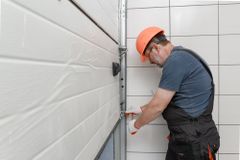
If you're like most homeowners, you don't just have a car behind your garage door. Americans use this space for everything from recreation to added storage. When you put items like extra furniture here, you want to be sure they won't get damaged from rain, snow, wind, or cold. Appropriately insulating the garage will help keep your belongings safe. Follow these tips to keep the interior snug and secure, even when temperatures are dropping.
3 Steps for Insulating Your Garage
1. Check for Cracks & Holes
 Check the garage for any cracks and holes that will let in cold air or moisture, particularly around windows, doors, and electrical outlets. Seal any openings you find. It's also smart to cover and seal the switches and outlets.
Check the garage for any cracks and holes that will let in cold air or moisture, particularly around windows, doors, and electrical outlets. Seal any openings you find. It's also smart to cover and seal the switches and outlets.
2. Upgrade the Garage Insulation
The garage walls may not provide as much insulation as those in your house, but you can pad them with foam board for added warmth retention. This material can be easily cut to size and has a high R-value, which determines a material's insulating ability.
The garage door isn't as thick as the walls, so look into replacing yours with one built with greater insulation.
3. Add Weatherproofing
Weatherstripping keeps cold air from coming in along the cracks around garage doors and window. A simple rubber strip can be affixed along the door's bottom. Since the plastic can become brittle and crack due to exposure over time, check it every year to see if it needs replacing. You can also caulk the perimeter of the door.
For assistance preparing your garage door for winter, contact Walter E. Williams of Easton, CT. These professionals have served both commercial and residential customers since 1950. Visit their website for a full list of services, from overhead door installation to spring replacement. To make an appointment, call (203) 488-8620.
About the Business
Have a question? Ask the experts!
Send your question

